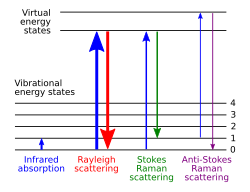In quantum physics, a virtual state is a very short-lived, unobservable quantum state.[1]

In many quantum processes a virtual state is an intermediate state, sometimes described as "imaginary"[2] in a multi-step process that mediates otherwise forbidden transitions. Since virtual states are not eigenfunctions of any operator,[3] normal parameters such as occupation, energy and lifetime need to be qualified. No measurement of a system will show one to be occupied,[4] but they still have lifetimes derived from uncertainty relations.[5][6] While each virtual state has an associated energy, no direct measurement of its energy is possible[7] but various approaches have been used to make some measurements (for example see[8] and related work[9][10] on virtual state spectroscopy) or extract other parameters using measurement techniques that depend upon the virtual state's lifetime.[11] The concept is quite general and can be used to predict and describe experimental results in many areas including Raman spectroscopy,[12] non-linear optics generally,[5] various types of photochemistry,[13] and nuclear processes.[14]
See also
editReferences
edit- ^ "A glossary of terms in nuclear science and technology". Conference on Glossary of Terms in Nuclear Science and Technology. A series of nine sections. American Society of Mechanical Engineers. 1953. p. 61.
{{cite book}}:|work=ignored (help) - ^ Robinson AL (February 1985). "Tunable Far IR Molecular Lasers Developed: Stimulated Raman scattering associated with a series of closely spaced rotational states is the key to wavelength tunability". Science. 227 (4688). New York, N.Y.: 736–7. doi:10.1126/science.227.4688.736. PMID 17796721.
- ^ Masters BR (2008). "Historical Development of Non-linear Optical Microscopy and Spectroscopy". In Masters BR, So P (eds.). Handbook of Biomedical Nonlinear Optical Microscopy. US: Oxford University Press. p. 10. ISBN 978-0-19-516260-8.
- ^ Wardle, David (1999). Raman scattering in optical fibres (Thesis). p. 22. hdl:2292/433.
- ^ a b Abbi SC, Ahmad SA, eds. (2001). Nonlinear Optics and Laser Spectroscopy. Alpha Science International, Limited. p. 139. ISBN 978-81-7319-354-5.
- ^ Norman P, Ruud K (2006). "Microscopic theory of nonlinear optics.". In Papadopoulos MG, Sadlej AJ, Leszczynski J (eds.). Non-Linear Optical Properties of Matter. Dordrecht: Springer. p. 3. ISBN 978-1-4020-4849-4.
- ^ Belkic D (2004). "The Dyson Perturbation Expansion of the Evolution Operator". Principles of quantum scattering theory. CRC Press. p. 70. ISBN 978-0-7503-0496-2.
- ^ Saleh BE, Jost BM, Fei HB, Teich MC (April 1998). "Entangled-Photon Virtual-State Spectroscopy" (PDF). Physical Review Letters. 80 (16): 3483–3486. Bibcode:1998PhRvL..80.3483S. doi:10.1103/PhysRevLett.80.3483.
- ^ Kojima J, Nguyen QV (1 October 2004). "Entangled biphoton virtual-state spectroscopy of the A2Σ+–X2Π system of OH". Chemical Physics Letters. 396 (4): 323–328. Bibcode:2004CPL...396..323K. doi:10.1016/j.cplett.2004.08.051.
- ^ Lee DI, Goodson III T (2007). Nunzi JM (ed.). "Quantum spectroscopy of an organic material utilizing entangled and correlated photon pairs". Linear and Nonlinear Optics of Organic Materials VII. 6653. International Society for Optics and Photonics: 66530V. Bibcode:2007SPIE.6653E..0VL. doi:10.1117/12.745492. S2CID 122068309.
- ^ Boitier F, Godard A, Rosencher E, Fabre C (13 April 2009). "Measuring photon bunching at ultrashort timescale by two-photon absorption in semiconductors". Nature Physics. 5 (4): 267–270. Bibcode:2009NatPh...5..267B. doi:10.1038/nphys1218.
- ^ Griffiths PR, De Haseth JA (2007). Fourier Transform Infrared Spectrometry. Vol. 83 (second ed.). Wiley-Interscience. p. 16. ISBN 978-0-470-10629-7.
- ^ Strehmel B, Strehmel V (January 2007). "Two-photon physical, organic, and polymer chemistry: theory, techniques, chromophore design, and applications.". Advances in Photochemistry. Vol. 29. John Wiley and Sons. pp. 111–354 (116). doi:10.1002/047003758X.ch3. ISBN 978-0-471-68240-0.
- ^ Breit G (April 1967). "Virtual Coulomb excitation in nucleon transfer". Proceedings of the National Academy of Sciences of the United States of America. 57 (4): 849–55. Bibcode:1967PNAS...57..849B. doi:10.1073/pnas.57.4.849. PMC 224623. PMID 16591541.